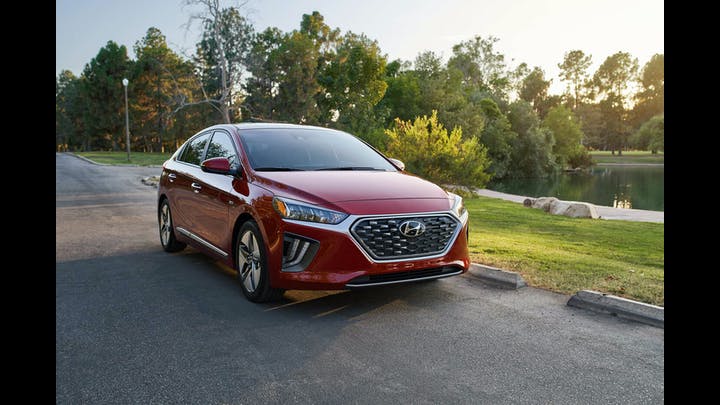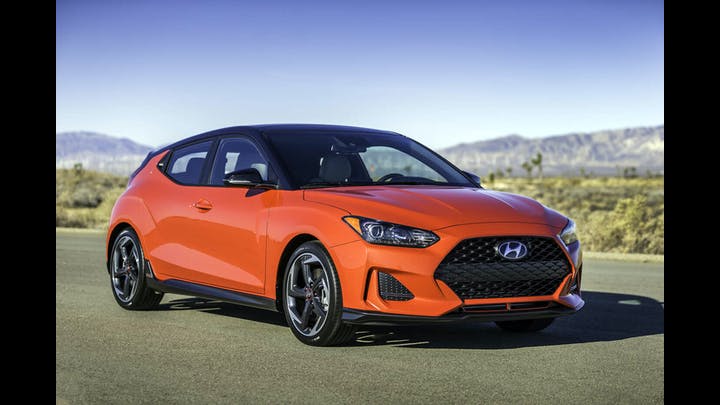
The Hyundai Ioniq is a four-door hybrid hatchback that combines usability and efficiency. It comes with a long list of standard safety features and is available in hybrid and plug-in hybrid versions, but the back seat is cramped and baggage space is limited.
Overview
Whatever type of electric vehicle you desire, the Ioniq has a model for you. This five-door hatchback comes in hybrid or plug-in hybrid variants and seats five people. There are several Ioniq trims available, all of which will help you save money on gas. With a long list of standard safety features and a robust guarantee, the Ioniq is a terrific value. It has a nice and comfy inside, but there isn’t much room in the back. The Ioniq’s cargo space is also limited, although the hatchback’s versatility allows it to transport bulkier objects. The internal materials are top-notch, and the styling is appealing and modern.
The Toyota Prius, a hybrid with optional all-wheel drive, and the Toyota Prius Prime plug-in hybrid are competitors. The Kia Niro combines electrified options with crossover versatility.
Trims and Costs
Hybrid Blue, Hybrid SE, Plug-In Hybrid SE, Hybrid SEL, Plug-In Hybrid SEL, Hybrid Limited, and Plug-In Hybrid Limited are the seven trims offered for the Hyundai Ioniq. There are no other packages available. The Plug-In Hybrid SEL is the most popular trim, and it’s also our favorite. We’ll explain why in a moment.
Blue Hybrid
The Hybrid Blue has a 1.6-liter four-cylinder engine, one electric motor, a 32-kW battery, six-speed automatic transmission, front-wheel drive, 15-inch wheels, cloth seats, a six-way adjustable driver’s seat, 8-inch infotainment touchscreen, wireless Apple CarPlay and Android Auto, forward-collision avoidance assist with pedestrian detection, lane-keeping assist, and driver attention warning for $24,405 (including a $1,005 destination fee
SE Hybrid
The Hybrid SE ($26,355) adds a 10-way power driver’s seat with adjustable lumbar support, heated front seats, a leather-wrapped steering wheel and shift knob, steering wheel-mounted paddle shifters, SiriusXM, heated side mirrors, intermittent wipers, LED daytime running lights, and blind-spot warning with rear cross-traffic alert, as well as SiriusXM.
SE Plug-In Hybrid
A 45-kW battery, charging port, 16-inch wheels, LED headlights and taillights, dual-zone climate control, auto-dimming rearview mirror, forward-collision avoidance assist with pedestrian and cyclist detection, lane-following assist, and smart cruise control with stop-and-go capability are all included in the Plug-In Hybrid SE ($27,705).
SEL Hybrid
The engine in the Hybrid SEL ($29,605) is the same as in the Blue. It comes with 17-inch wheels, a power tilt-and-slide sunroof, and wireless device charging.
SEL Plug-In Hybrid
The Plug-In Hybrid SEL costs $30,705 and comes with the same battery as the Plug-In Hybrid SE. A 10-way power driver’s seat, blind-spot detection, and rear cross-traffic alert are all included. This model is recommended because it combines the practicality of a plug-in hybrid drivetrain with attractive enhancements for just over $30,000.
Limited Hybrid
The Hybrid Limited ($32,405) includes power-folding side mirrors, puddle lights, leather seats, driver’s seat memory, ambient lighting, an eight-speaker Harman Kardon audio system, 10.25-inch infotainment touchscreen, navigation, highway driving assist, and front and rear parking sensors, in addition to the same battery as the Blue and Hybrid SEL.
Limited Plug-In Hybrid
The battery in the Plug-In Hybrid Limited ($34,155) is the same as in the Plug-In Hybrid SE and SEL. A power tilt-and-slide sunroof is included.
Performance and Engine
For a total of 139 horsepower, the Ioniq combines a 1.6-liter four-cylinder engine with an electric motor. A six-speed automatic transmission handles shifts. You’ll be disappointed if you’re searching for quick acceleration. The emphasis here is on efficiency rather than performance. The Ioniq engine takes a long time to accelerate and has little power left over for passing on the highway. The Ioniq Plug-In adds an 8.9-kWh battery for an estimated 29 miles of pure electric range, but else functions similarly to the conventional hybrid. Regardless of which option you select, the ride is composed, with easy handling that is well-suited to regular commutes. It emphasizes on economy and cost-effectiveness rather than driving dynamics. The Ioniq is an excellent pick if you’re ready to forego a fun drive in exchange for a cheap monthly gas price.
The Toyota Prius and Toyota Prius Prime have comparable easy driving characteristics, but the Toyota Prius Prime accelerates significantly faster. Because of its greater weight, the Kia Niro is even less aggressive.
Interior
The front seats of the Hyundai Ioniq, which seats five people, are well-bolstered and pleasant. Fabric trims are appealing, and leather is available on higher trim levels. The front cabin is more spacious than imagined, with an open, breezy vibe. Three persons could fit in the back seats, but two would be considerably more comfortable. The slanting roofline of the Ioniq renders the back seat unsuitable for tall adults. This is a budget vehicle, so the interior luxuries won’t blow you away, but the quiet, appealing cabin makes it a terrific commuter car. The hybrid has 26.5 cubic feet of cargo space, while the plug-in hybrid has 23.0 cubic feet. Although there isn’t a lot of room, the hatchback makes it easy to get in and out, and the fold-down rear seats can carry heavier objects.
The Toyota Prius has more cargo room, however the Kia Niro has more cargo and passenger space.

